A Changed World

COVID-19 led to an unprecedented evacuation of Peace Corps volunteers—among them nearly two dozen Emory alumni—from around the world on March 15, 2020. As uncertainty about the pandemic persists, what happens next for the agency, its volunteers, and the vital humanitarian needs it serves both in the US and around the globe?
I. Evacuation
As February 2020 rolled into March and COVID-19 began to burn its way across the globe, Gordon Brown 95C knew that it was only a matter of time before it hit Ghana. As country director for the oldest Peace Corps program in the world, Brown is charged, first and foremost, with overseeing the safety and well-being of scores of in-country volunteers. Every day brought news of more nations closing borders and suspending flights.
“It looked like Ghana was going to close,” Brown says. “It happened within the span of probably half a day.”
Peace Corps, a federal government agency, had already evacuated volunteers from China in January and closed that country’s program. Volunteers were pulled from Mongolia at the end of February. In Ukraine and elsewhere, other evacuations had begun.
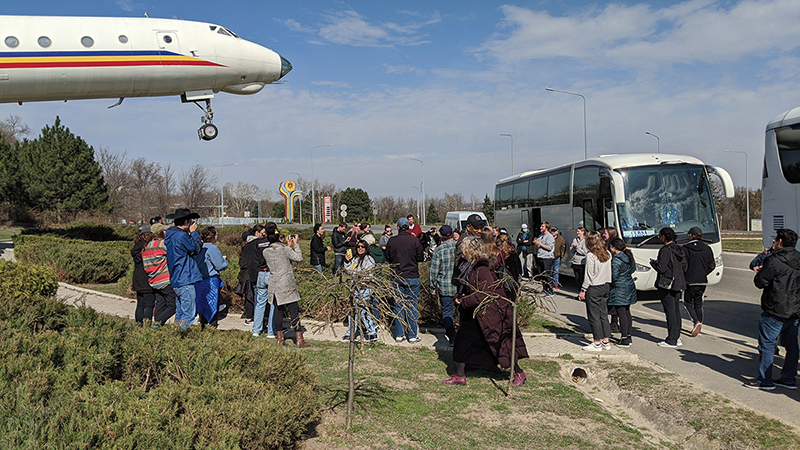
Peace Corps volunteers in Moldova take final photos together as they congregate one last time before flying back to the United States
On, Sunday, March 15, US-based Peace Corps Director Jody Olsen made the unprecedented decision to evacuate all 7,300 volunteers from more than sixty countries. What followed was a massive logistical effort—and a shunting aside of the norms of how Peace Corps likes to operate: consensus driven, community focused. With the evacuation, there just wasn’t time. Some two dozen Emory alumni were among those volunteers ripped from their communities and countries, sometimes with only a few hours’ notice.
In Ghana, Brown says, it had already been a tough several months for his Peace Corps program. In October 2019, one Peace Corps volunteer died after a tragic gas accident in her home. And, later on, thirty-nine volunteers had to be relocated out of northern Ghana because of security concerns from across the border. But Brown is no stranger to such challenges. He has served as Ghana’s country director since 2018. He led Peace Corps Benin before that, and he had served as a volunteer in Niger from 1996 to 1998.
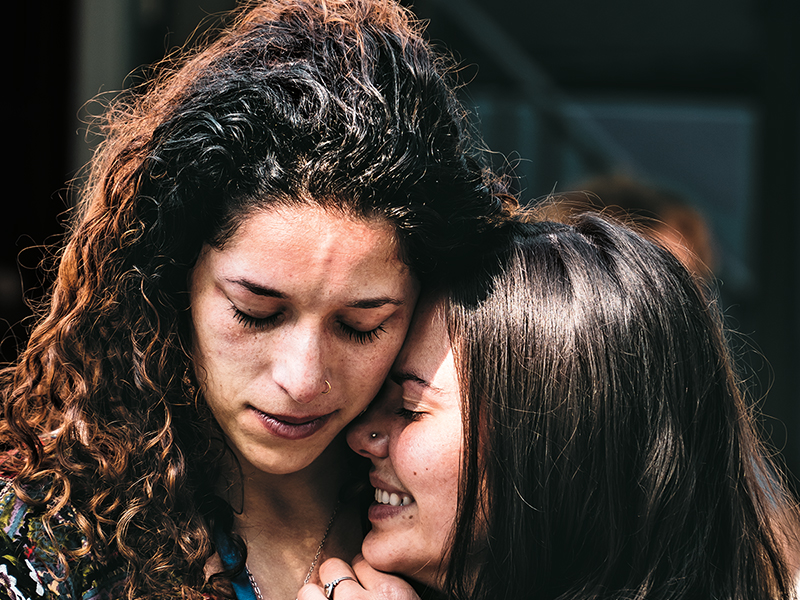
Volunteers in Nepal hug and share heartbroken goodbyes, unsure if they will ever see each other or their country of service again.
When the time to evacuate came that week in March, Brown faced another personal challenge: His wife had injured her leg and was in a wheelchair. “When it was time to evacuate, we had the eighty volunteers, my wife in her wheelchair, our three-year-old, our seven-year-old, plus luggage,” he recalls “It was difficulty with level ten on that one.”
Lucy Baker 18C had already made her way home to the San Francisco Bay Area when the global evacuation unfolded. She had been serving as a health volunteer in southwestern Mongolia when the outbreak of coronavirus occurred in Wuhan, China. Mongolia was one of the first countries that quickly went into preventive lockdown.
Baker had been teaching in a Mongolian high school and helped her colleagues implement a new health curriculum. She studied biology at Emory, and she’s long been intrigued by how infectious diseases affect us— both our bodies and, as she says “how the world reacts to them—as evidenced now.” Her junior year at Emory took her to Botswana to study HIV-AIDS and public health. She was drawn to Peace Corps service because she wanted to give something in return. After two years volunteering in Mongolia, she was planning to stay on for a third year, working with an NGO, called Youth for Health, in the capital city of Ulaanbaatar.
In Congress, multiple pieces of bipartisan legislation are in the pipeline to put returned volunteers to work battling the pandemic, though so far none have passed.
But she was destined to go home much earlier than she had planned. Korean Air, which provides 70 percent of flights out of Mongolia, halted flights and set a different endgame in motion. If Peace Corps needed to medically evacuate someone, i might not be possible. So the country program suspended operations. “I had about thirty-six hours to pack up everything and say goodbye,” Baker says. Colleagues came over at midnight to say farewell. “That was very hard.”
Baker and the newest volunteers were put on “administrative hold,” with hopes they would return in a few months. But mid-March, when the global evacuation began, Baker learned via an FAQ page that her service had ended. It was a new level of heartbreak.
For Baker’s former classmate Diane Glover 16Ox 18C, the evacuation meant that she had to leave her birthplace. Glover was born in the Philippines and left at age eleven to come to the United States, where she was raised by her older sister in Washington State and Georgia.
She returned to the country as a Peace Corps volunteer in July 2018, with her assignment as a youth development volunteer taking her to Tacloban City on the island of Leyte, where she worked with street children. One key effort she helped lead was a project that rented out skateboards to kids— but not for money. Skateboards were used to attract the children into the community office where she worked. Every minute they participated in training—reading, writing, gardening—bought skateboarding time.
Working in youth development taught Glover a new way to redefine success: “I couldn’t necessarily say, ‘I transformed six lives today,’” she shares. “Most of the time we don’t see success until further down the road in their lives.”
Just when she was settling in and making an impact, Glover’s road took a hard turn.
Sarah Bair 19C was in her village in Togo when she got a call from a friend at 4 a.m. on the morning of Monday, March 16. Bair was working as a health volunteer; human health and international relations had drawn her to Emory. She was working in the prefecture of Tchamba—“the Muslim capital of Togo,” she says. She went to mosque every Friday and learned both how religion affects health and how to connect health education to religion. She also coached two girls’ soccer teams. She used one practice each week for a health talk—washing hands, nutrition, setting a healthy lifestyle.
She had two days to say goodbye.
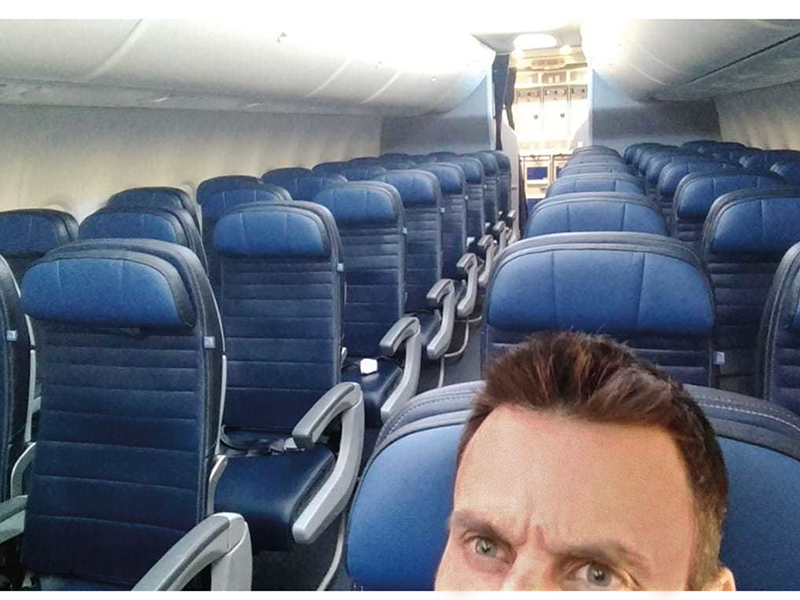
Peace Corps volunteer Adam Greenberg returns to San Diego on an almost completely empty flight on March 23.
Danny Herres 09C was in Malawi, serving as a community health specialist in a village of about one thousand people near Lilongwe. He found out about the evacuation at 4:30 in the morning, via WhatsApp. He had three hours to prepare before a car arrived to take him to the capital.
Herres was the first Peace Corps volunteer to serve the area. “No one had ever come in as a foreigner, built relationships, been a community member, and then found other motivated individuals and kind of helped them grow in the way that I was doing,” he says.
Much of his work involved HIV-AIDS education and prevention. There was a grassroots soccer program serving youth ages ten to nineteen, where he used soccer drills as metaphors to teach about the differences between safe and unprotected sex. There was also a project with a local secondary school regarding HIV stigma and bullying, an HIV support group focused on nutrition and gardening vegetables, an initiative teaching female students how to make reusable sanitary pads, and a project on malaria prevention strategies. “For me it was just heartbreaking to leave.”
II. Homecomings—and A National Reckoning
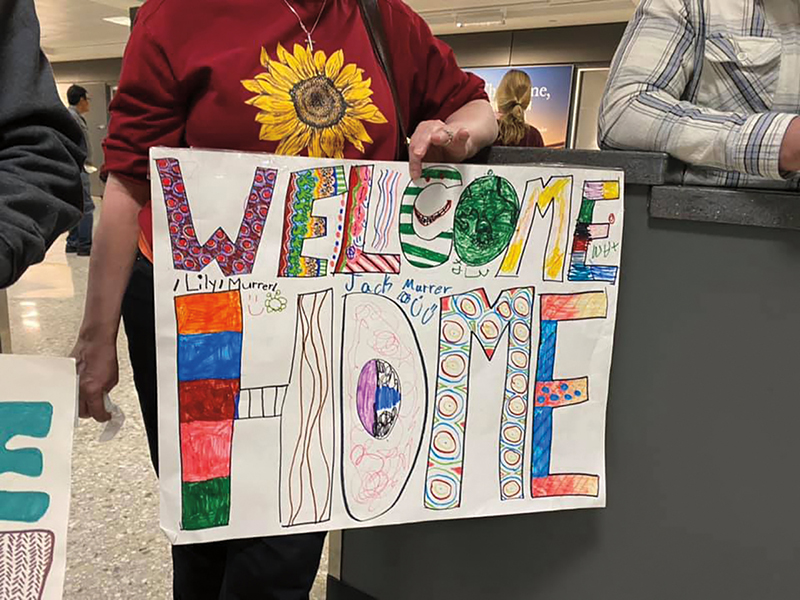
The global evacuation was a tremendous feat of logistics for everyone involved: the agency, local staff, volunteers, and embassy and host country partners. For the several thousand volunteers, it was also a rude welcome home. They returned to a country hit by pandemic and economic maelstrom.
Volunteers had to self-quarantine for two weeks; sometimes that meant staying in a hotel or with friends to protect vulnerable family members. Peace Corps closed service for volunteers to unlock some benefits, but that led to the perception that volunteers had been “fired,” as one Washington Post headline put it.
In fact, one sticking point for returning volunteers has long been that they’re not eligible for unemployment— since technically they’re not employees. Reentry is often hard, even under normal circumstances; many argue it’s the toughest part of the whole experience. It’s even tougher for volunteers yanked from communities with no notice.
Many of them were hurting and struggling, says Maricarmen Smith-Martinez 04C. She was a volunteer herself in Costa Rica from 2004 to 2006, and now serves as chair of the board of the nonprofit National Peace Corps Association (NPCA)—an independent advocacy organization that works to bolster support for Peace Corps in Congress, to amplify the social impact of the Peace Corps community, and, in a broad sense, to ensure that Peace Corps is the best it can be.
NPCA rolled out a program called Global Reentry to support returning volunteers with resources, advice, advocacy, and training. The Peace Corps community did a lot of self-organizing, too. “It’s very inspiring to see how people are responding and providing support in any way they can for the evacuees,” says Smith-Martinez. “A listening ear, a bag of groceries, a ride from the airport, a home post-quarantine.”
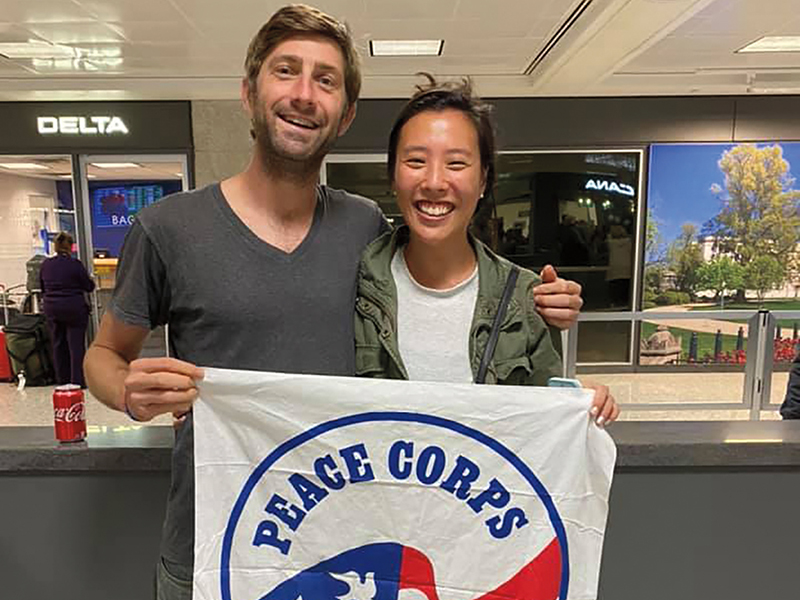
RETURNING TO A CHANGED HOME Peace Corps volunteers were welcomed back to the US with open arms, but they were not prepared fully for the conditions to which they returned: a burgeoning coronavirus pandemic that was shutting down commerce and forcing citizens to shelter in place and an uprising of protest and social unrest against systemic racism
Some evacuated volunteers sought to help communities in the US: making masks, donating blood, working at food banks, working as contact tracers, or helping with COVID testing. In Congress, multiple pieces of bipartisan legislation are in the pipeline to put returned volunteers to work battling the pandemic, though so far none has passed. What did pay off: NPCA advocacy efforts to extend health insurance benefits, and to get the Department of Labor to issue rules that evacuated volunteers were eligible for pandemic unemployment assistance.
This summer has also begun a national reckoning long overdue. Since the killing of George Floyd on Memorial Day, protests have swept across this nation and scores of others: against the killing of unarmed Black men, women, and children by police and others. As a society, we’re grappling with hard questions of how to confront systemic racism and how it has shaped institutions large and small—including Peace Corps. The sometimes painful experiences of volunteers who are people of color, and how the agency needs to do better with addressing racism on all fronts, was part of the conversation woven through a series of town halls and a global ideas summit that NPCA hosted in July. The premise of those meetings was to ask: What are the big ideas for Peace Corps going forward?
Gordon Brown notes that as a government agency, Peace Corps has been one of the most progressive in terms of racial justice and diversity. But along with efforts to ensure that Peace Corps reflects the best of American ideals in the volunteer experience, there’s still a long way to go in ensuring that Blacks and other people of color hold leadership positions—as country directors and above.
As Maricarmen Smith-Martinez noted in her closing remarks for the summit, it’s clear that the work of Peace Corps can’t be just a return to business as usual. The world has changed. And Peace Corps needs to change, too. In part, there needs to be a greater emphasis on “solidarity, not charity,” as one speaker from Nepal put it at the summit, and a better understanding of how responsibility is woven together with privilege.
In July, Peace Corps Director Jody Olsen brought on board a senior adviser for diversity, equity, and inclusion and announced a task force. What recommended changes look like more broadly is also taking shape, in part, in reports for policymakers and the public that NPCA is working on for the fall, driven by conversations in the Peace Corps community of a quarter million returned volunteers and former staff.
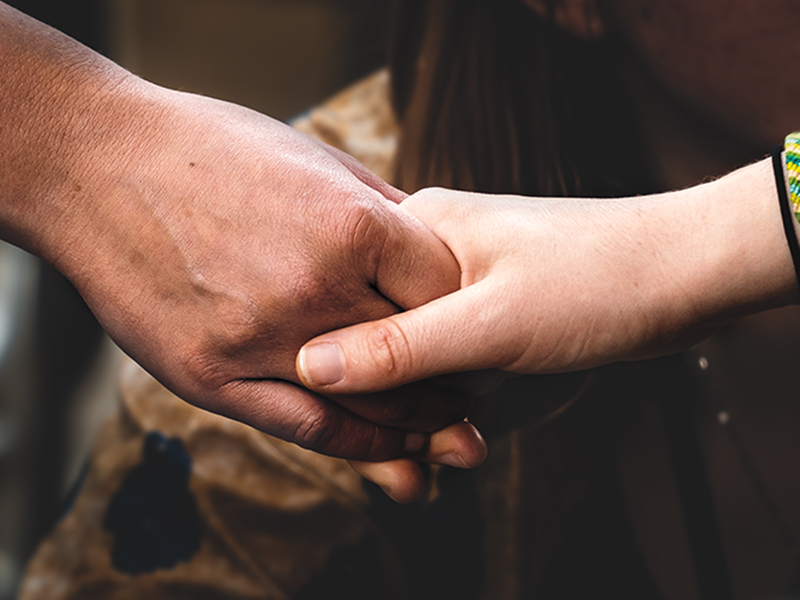
III. The Way Back
“Fundamentally, Peace Corps is a grassroots program about friendship and having that connection in the world,” says Smith-Martinez. “Peace Corps has a very important role to play in reestablishing world trust.”
So when will volunteers return to the field? Initially, Peace Corps announced October 2020. Now the estimate for first redeployment is January 2021.
But this won’t happen all at once. “It’s gonna be massive in terms of charting the way forward, what the focus areas are going to be, what the footprint is going to be, what countries, what sectors,” says Ghana Country Director Gordon Brown. “All of that is going to have to be decided on an individual basis.”
Peace Corps will be watching how embassies around the world assess situations—and decisions won’t be unilateral. After all, we’re still in the midst of a global pandemic. “As we solve the issue in the United States—and I’m hopeful we will—that doesn’t mean that every other country has solved it for themselves,” Brown says. “For each of the sixty-one countries, both sides will need to make the determination that it’s safe for volunteers to return. Negotiating that area is going to require some real diplomatic skill.”
In Mongolia, community spread was never a problem; they’re eager to have back volunteers. Ukraine is asking to expand the program—already the largest in the world. One possibility is deploying Peace Corps response volunteers first. Traditional volunteers serve a two-year assignment; response volunteers are experienced professionals sent on short-term assignments. But in the post-COVID world, safety comes first. “I don’t want anybody to be in the position where they will get sick,” Brown says. “There’s no room for error.”
Meanwhile, this summer Peace Corps announced a new program which can be used to permanently close the program in China.
As for evacuated volunteers, what now? Lucy Baker, who left Mongolia, has taken a job with Public Interest Research Group in Washington, D.C. One basic lesson from all this, she says: “Curveballs are real.”
Diane Glover, back from the Philippines, is working at Emory as a contract coordinator. “The fact that most of the volunteers are brokenhearted just means that we were doing good,” she says. “You know, Peace Corps volunteers truly represent the best of America.”
Daniel Herres stayed briefly at his parents’ house in North Carolina before traveling to the isle of Lesvos to work with refugees, supervising a COVID-19 response project with the Starfish Foundation. He’s in touch with friends in Malawi weekly, though he’s dismayed that projects have been put on hold. In September he began a master’s in humanitarian aid and conflict at the University of London. “I would love to see more Emory alumni apply for Peace Corps,” he says.
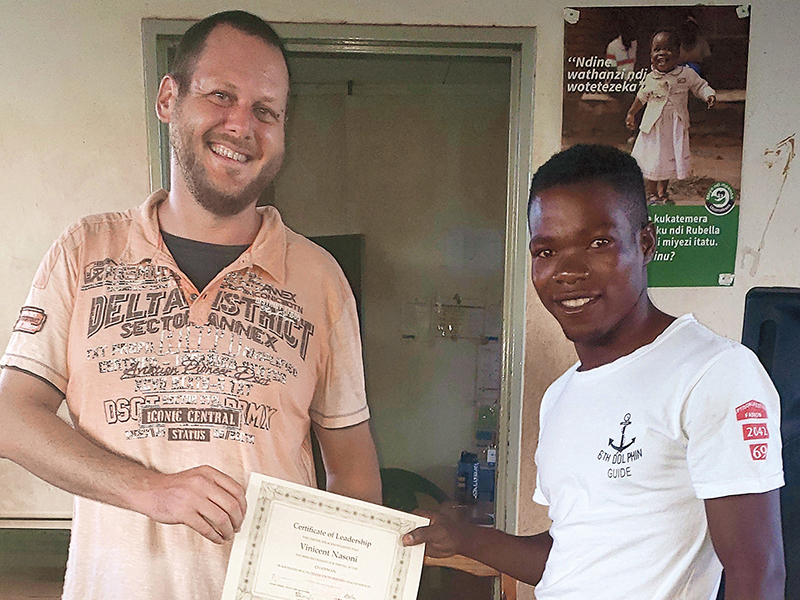
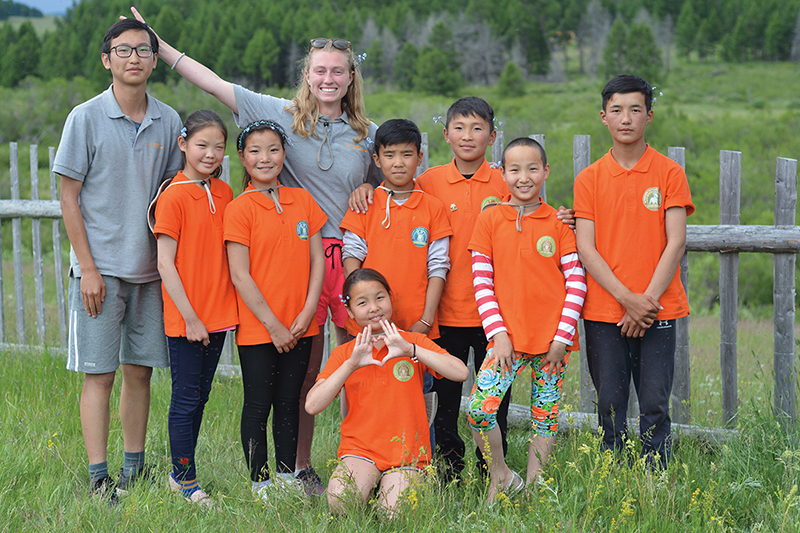
Volunteers like Emory alumni Danny Herres (top) and Lucy Baker (bottom) are hopeful that the Peace Corps will soon be able to return to full operations and that they and others may have further opportunities to serve in countries like Malawi and Mongolia.
Sarah Bair returned home to the Washington, D.C., area to stay with family. Seeing that she wouldn’t be able to return to service quickly, she was grateful that Emory’s Rollins School of Public Health extended application deadlines and encouraged volunteers to apply. She’s just begun a master's program, concentrating on community health at the Hubert Department of Global Health. She also submitted her application for reinstatement as a volunteer—waiting to see if and when that opportunity reopens.
Peace Corps was founded by President John F. Kennedy in 1961—so the agency is just on the cusp of sixtieth anniversary celebrations with no volunteers in the field.
“When I tell the history to new volunteers, I remind them that 1961 was the year of Africa,” Brown says. “Some twenty countries became independent. The Prime Minister of England, Harold Macmillan, gave a speech in 1960 and said, Look, the winds of change are blowing, and we can’t stop them. The winds of freedom.”
Very different winds are blowing right now.
Brown studied philosophy at Emory. He was drawn to it because it posed big questions. Here’s one: “How do we stay true to the original mission—the philosophical underpinnings of Peace Corps? It takes courage to stand up and say, it’s 2020 and I still believe in being committed to something. I believe in things we can’t see. There are things that are not monetary that are good in this world. At Emory, we talk about the generosity of spirit. You know, at its heart, Peace Corps is supposed to be about world peace and friendship. If we don’t always achieve our development goals, as long as we are amplifying goodwill and amplifying world peace and exhibiting the best of what America is supposed to be about, and sharing that with people of other countries, then it’s been a great success.”




